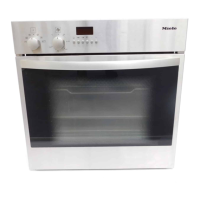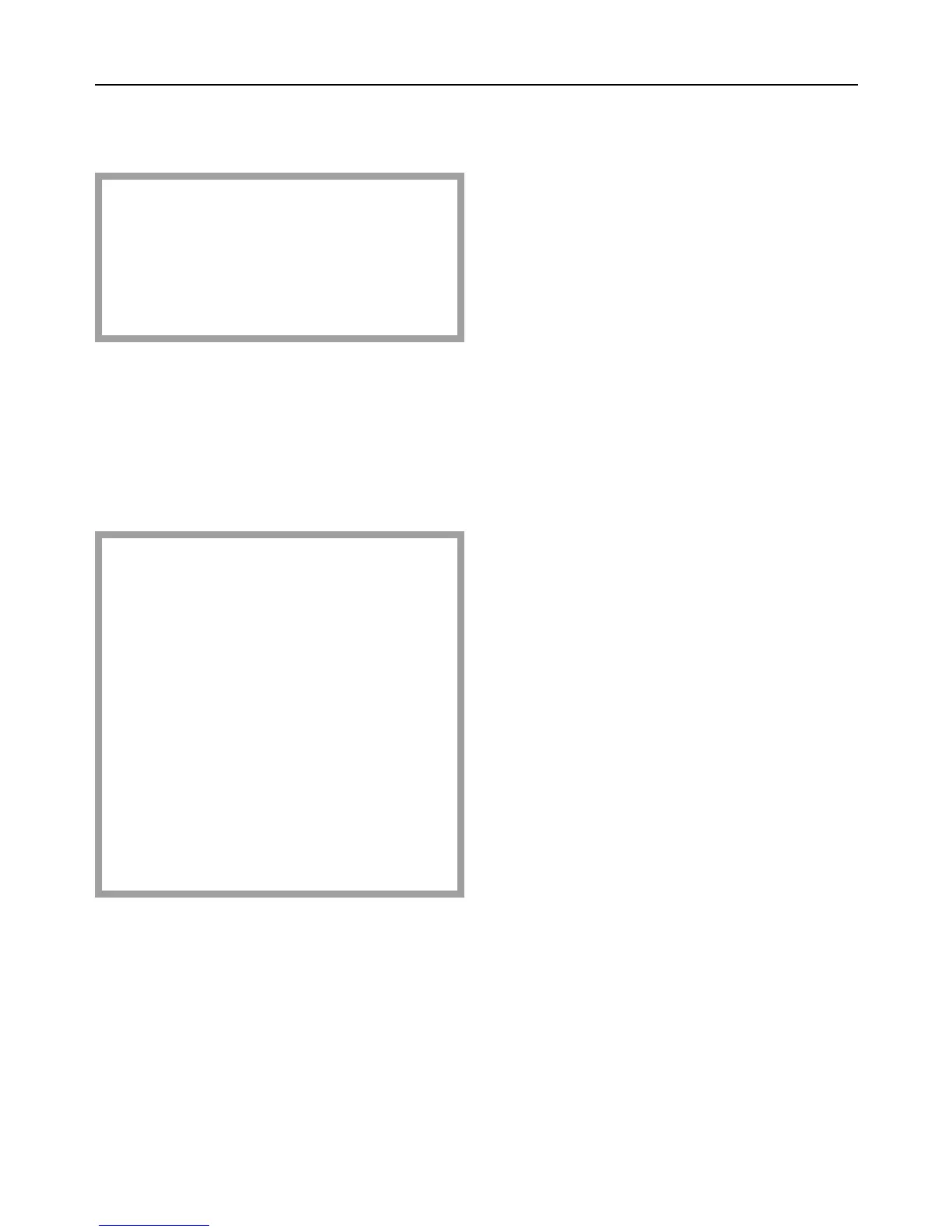
 Loading...
Loading...
Do you have a question about the Miele H 310 and is the answer not in the manual?
Visual overview of the appliance, identifying numbered components on the front and interior.
Detailed breakdown of the appliance's control panel, explaining each element.
Description of the internal features and parts of the oven cavity.
Visual overview of a different appliance model, identifying numbered components on the front and interior.
Detailed breakdown of the control panel for a different appliance model, explaining each element.
Description of the internal features and parts of the oven cavity for a different appliance model.
Lists the standard accessories provided with the oven, such as trays and pans.
Information on ordering other accessories from the dealer or spare parts department.
Lists the hob models that can be combined with the cookers.
Instructions on where to place and how to use the hob's data plate.
Explains the cooking zones and display field for ceramic hobs KM 215 and KM 228.
Details the cooking zones for ceramic hobs KM 213 and KM 227, noting differences.
Identifies the cooking zones and control buttons for the KM 200 enclosed hotplate hob.
Guidelines for safely disposing of or recycling transport and protective packaging materials.
Advice on contacting dealers or waste centres for recycling old appliances.
States compliance with safety requirements and emphasizes reading instructions to prevent accidents.
Defines the intended domestic use of the appliance and warns against misuse.
Covers electrical safety, earthing, built-in operation, and avoiding tampering with components.
Procedures for isolating the appliance from power and warnings against using extension leads.
Notes on building the oven into units and suitability for maritime or mobile installations.
Precautions for operating the oven, including high temperatures, children's safety, and use of gloves.
Safety advice regarding oven use, including plastic containers, unopened tins, door handling, and foil use.
Warnings about hot cooking areas, residual heat indicators, and pan base suitability.
Safety guidelines for ceramic hobs, including handling breakages, spills, and avoiding certain pan types.
Safety advice for hobs with enclosed hotplates, covering heat, spills, and misuse.
Important advice on unattended cooking, room heating, food cooking, and cable safety near hot zones.
Warnings about steam cleaners, alcohol in recipes, and pest control affecting the guarantee.
Instructions for safely disconnecting and disposing of old appliances.
Instructions on how to set the appliance's timer display.
Guide to setting the current time on the appliance's digital display.
Explanation of how to switch between timer and manual oven operation.
Steps for cleaning the inside of the oven before the first use.
Instructions for cleaning the ceramic hob surface before initial use.
Guidance on initial use of enclosed hotplates, including potential smells and ventilation.
Explains cooking zones, residual heat indicators, and extended areas on ceramic hobs.
Describes the different sizes and performance levels of enclosed hotplates.
Instructions on how to operate the controls for cooking zones/hotplates safely.
Advice on selecting settings for boiling, frying, and continuing cooking efficiently.
A chart providing recommended heat settings for various cooking tasks.
Guidance on choosing the right pans for optimal cooking results and economy.
Information on pan base flatness and the importance of using lids for heat retention.
Tips for efficient hob use, including saucepan placement, cleaning, and preventing scratches.
Additional advice for ceramic hobs regarding grit, pan edges, and metallic sheen marks.
Extra tips for enclosed hotplates, focusing on avoiding wetness and corrosion.
Explains how the fan circulates heated air for even cooking at lower temperatures.
Describes how the grill, bottom heat, and fan work together for quick heating.
Explains the radiant heat method from above and below, suitable for long cooking times.
Details how the upper heating element functions as a grill for browning and cooking.
Explains how the fan distributes grill heat for more efficient grilling.
Identifies the oven function selector and temperature selector.
Explains how to use the function selector, including its operational limits.
Describes the purpose and use of each oven function: Light, Conventional, Grill, Rapid Heat-up, Fan Heat, Fan Grill.
Details how to use the temperature selector to set the oven's cooking temperature.
Instructions on operating the oven manually using the function and temperature selectors.
Explains when pre-heating is necessary for different oven functions and specific foods.
Describes the features of the baking tray, grill pan, and rack, including non-tip notches.
Explains the purpose and correct use of the roasting filter for fan-assisted cooking.
Describes the function of the handle for safely removing oven accessories.
Explains the use of the anti-splash tray during grilling and roasting to collect juices.
Explains the meaning of symbols appearing in the timer display.
Details the functions of the various buttons used to operate the timer.
Guide to setting the current time on the appliance's display.
Instructions for using the minute minder function for timing activities.
How to set automatic switch-off and delayed start cooking times.
Procedures for viewing and modifying entered cooking or timer settings.
How to cancel an active automatic cooking program.
Options for selecting different audible tones for timer alerts.
Suggests Fan Heat and Conventional settings for baking.
Advice on choosing suitable materials for tins and dishes based on heating system.
Recommended runner positions for baking on one, two, or three levels using Fan Heat.
Guidance on using dark metal tins, rich fruit cakes, and pre-heating for Conventional mode.
Tips on placing rectangular tins, testing for doneness, and selecting runner height.
Chart detailing temperatures, runner positions, and times for various baked goods using Fan Heat.
Chart detailing temperatures, runner positions, and times for various baked goods using Conventional Heat.
Suggests Fan Heat and Conventional settings for roasting.
Reminds to fit the roasting filter for Fan Heat roasting.
Recommends using covered pots for roasting to retain juices and keep the oven clean.
Advice on shelf positions and temperature adjustments for open roasting.
Methods for calculating roasting times based on meat type and weight.
Advice on temperature selection, browning, and resting the roast after cooking.
Specific tips for roasting poultry and defrosting deep frozen meat before cooking.
Temperatures, runner positions, and times for roasting various cuts of beef and veal.
Temperatures, runner positions, and times for roasting pork and lamb cuts.
Temperatures, runner positions, and times for roasting different sizes of poultry.
Recommends using Fan Heat up to 50°C or cool air circulation for defrosting.
Advice on food preparation, handling liquids, and poultry defrosting for hygiene.
Guidance on oven settings and dish selection for cooking casseroles.
Advice on covering dishes for steaming or using foil/parchment if no lid is available.
Brief mention of poaching fruit/fish and bottling, requiring experienced users for bottling.
Using the Rapid Heat-up function for convenience meals like pizza and lasagne.
Instructions on pre-heating the grill, door position, and selecting grill settings.
Tips on cleaning, seasoning food, and preparing fish for grilling.
How to assemble the grill pan and place food on the rack for grilling.
Advice on selecting appropriate levels for thin and thick cuts and estimating grilling time.
Tips on turning food, testing doneness by touch, and achieving desired results.
Chart with recommended runner positions, temperatures, and times for grilling various flat food items.
How to clean the ceramic hob surface, warning against abrasive cleaners and sharp objects.
Methods for removing light metallic sheen and lime deposits from the hob surface.
Procedure for removing sticky residues from the hob surface while warm.
Advice on using proprietary cleaners, avoiding heat, and the benefits of silicone-based cleaners.
How to clean hotplates and their surrounds, including drying procedures.
Instructions for cleaning the hob trough, avoiding abrasive materials and corrosion.
Cleaning instructions for white/coloured and stainless steel fronts and control panels.
Guidance on cleaning accessories like the roasting filter and baking trays.
Detailed guide on cleaning and maintaining PerfectClean surfaces, treating them like glass.
Methods for dealing with tough stains on PerfectClean surfaces, including soaking and scraping.
Warnings against using oven sprays and abrasives on PerfectClean surfaces.
How to use oven sprays on soiled areas, and warnings about chemicals damaging catalytic enamel.
Emphasizes regular cleaning of PerfectClean surfaces to maintain properties and avoid damage.
Describes the catalytic enamel, how splashes are burnt off, and the need for cleaning.
Instructions for cleaning catalytic panels using hot water, detergent, and a soft brush.
Using high temperatures to clean catalytic panels and manual cleaning for specific residues.
Steps for running the oven at high temperatures to clean catalytic surfaces.
Step-by-step guide on how to safely remove the oven door for easier cleaning.
Instructions for correctly re-fitting the oven door after removal, ensuring safety.
Steps to detach and remove the oven runners for cleaning or replacement.
Guide on how to remove and reassemble the catalytic side panels for cleaning.
Instructions for detaching and removing the oven's back panel.
Steps to safely lower the upper heating element for cleaning.
Troubleshooting steps if hob cooking zones do not warm up after switching on.
Checks to perform if the oven fails to heat up, including selector and fuse checks.
Guide to changing the oven bulb if the oven heats but the light does not work.
Explanation that cooling fan noise after operation is normal and not a fault.
Troubleshooting steps if baked goods are not cooked after following chart times.
Checks for uneven browning, relating to temperature, filter, and runner height.
How to remove spice deposits from catalytic surfaces.
Action to take after a power failure, including resetting the time and data.
Explanations for "0.00" display or "AUTO" flashing in the timer.
Steps for dismantling the oven door to clean condensation from between glass panes.
Further steps for dismantling oven doors with three glass panes, including removing the middle pane.
Instructions for re-fitting oven door glass panes, seals, and trim correctly.
Information on who to contact for faults and what details to provide, including model/serial numbers.
Description of the telescopic carriage for easy access to oven racks.
Details of the oven dish, its features, and availability.
Description of the pizza pan's suitability for various baked goods.
Information on catalytic side panels, their function, and fitting.
Emphasizes qualified personnel for electrical work and power isolation during installation/repair.
Where to find appliance data and matching it to the mains supply.
Details connection methods, isolator requirements, and accessibility of switches.
Provides diagrams for various AC power supply connections (3N, 2N, 1N).
Details the 3-core cable, wire colours, and earthing requirement for UK appliances.
Notes on the availability and connection of models with integrated hob controls.
Details voltage, fuse rating, wire colours, and earthing for Irish appliances.
Details electrical connection requirements and earthing for South African appliances.
Specifies minimum distances from walls, units, and hanging rails for safe hob installation.
Instructions for preparing the worktop cut-out for ceramic hobs KM 213 and KM 215.
Steps for setting the hob into the cut-out, securing it with clamps, and checking the seal.
Instructions for preparing the worktop cut-out for ceramic hobs KM 227 and KM 228.
Steps for laying and securing spring clamps for KM 227 and KM 228 hobs, including granite worktop variations.
Warnings about sealant use and instructions for lightly positioning and pressing down the hob.
Instructions for preparing the worktop cut-out for the KM 200 hob.
Steps for setting the KM 200 hob into the cut-out and securing it with clamps.
Safety precautions before connecting the cooker and following connection diagrams.
Steps for connecting the cooker cable, aligning it, connecting the hob plug, and pushing it into the base unit.
Instructions for screwing the oven to the side panels of the base unit.
Specifies the need for a ventilation cut-out behind the oven and its minimum size.
Safety precautions before connecting the oven to the electricity supply via an isolator.
Steps for placing the oven into the housing unit and securing it to the side walls.
Specifies the need for a ventilation cut-out in the interim shelf and its minimum size.